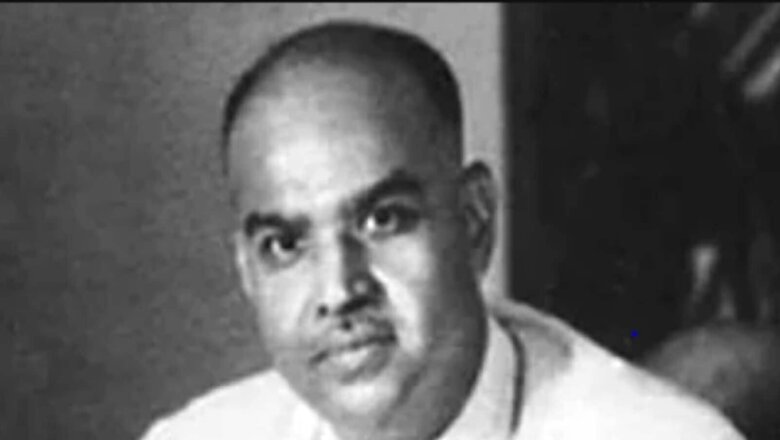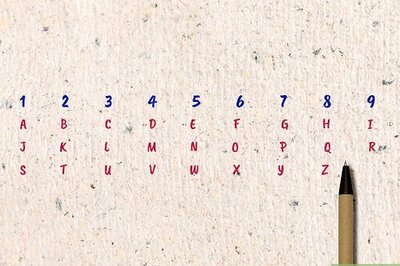
views
According to author Pushpesh Pant, the first mantra for victory is complete clarity about the goal. In his book, Victory Mantra, he writes: “The clarity of a goal helps the warriors in their preparation and in honing their aim on the battlefield… It is often said that wise people select goals that are reachable and realistic. But the interesting thing is that a person who achieves unprecedented and historic victories usually chooses destinations that appear out of reach to ordinary people.”
Syama Prasad Mukherjee was one such leader who could foresee the future and set an objective accordingly. His Kashmir endeavour might have seemed impossible at the time he was alive. But seven decades down the line, what Prime Minister Narendra Modi did on August 5, 2019, by abrogating Articles 370 and 35A, he fulfilled the dream for which Mukherjee lived and ultimately died.
Born in Calcutta on July 6, 1901, Mukherjee’s father was a judge in the Calcutta High Court and also the Vice-Chancellor of Calcutta University. Brilliant in academics, Mukherjee too became the Vice-Chancellor of Calcutta University in 1934 at the young age of 33, and remained in that position till 1938. He was elected as a Member of the Legislative Council of Bengal in 1929 as a Congress candidate. Later, he contested elections as an independent candidate and got elected to the same Council. He also became the president of the Hindu Mahasabha.
The history of the Bharatiya Jana Sangh began in October 1951, when it was formed by Mukherjee soon after he resigned from Jawaharlal Nehru’s cabinet over the Nehru-Liaquat pact of April 1950. The pact was signed between India and Pakistan in order to provide a framework for the treatment of minorities in the two countries.
The Pioneer, dated May 22, 1950, reported that 8,60,000 Hindus came to India as refugees. Between February 10, 1950 and February 20, 1950, 10,000 Hindus were killed. Some reports suggested that 13 lakh Hindu refugees entered West Bengal between April 9, 1950 and July 25, 1950.
Mukherjee was not satisfied with the pact and also the overall Nehruvian policies vis-à-vis Kashmir, Partition, Hindu-Muslim riots, appeasement of minorities, et al. The Nehru-Liaquat Pact was the final standoff that made Mukherjee part ways with the Nehru government.
Mukherjee was a great minister and many important projects like The Hindustan Aircraft Factory (Today’s Hindustan Aeronautics Limited), the Sindri Fertilizer Plant and The Chittaranjan Locomotive Works started during his tenure as Minister of Industry and Supply.
After leaving the Nehru Cabinet, Mukherjee formed the Jana Sangh with the support of the Rashtriya Swayamsevak Sangh (RSS) led by MS Golwalkar. Earlier in 1943, Mukherjee had met the founder of RSS, Dr Keshav Baliram Hedgewar, in the presence of Golwalkar. Mukherjee and Dr Hedgewar discussed the plight of Hindus in the then Bengal ruled by the Muslim League. It is said that during the course of the discussion, Mukherjee suggested to Dr Hedgewar that the “Sangh must take part in politics”, to which Dr Hedgewar said that the Sangh was “not interested in day-to-day politics”. It was only after meeting Golwalkar that Mukherjee felt that any political organisation supported by and enjoying the confidence of the RSS would surely succeed in mobilising and consolidating the non-Congress and non-communist nationalist public opinion.
Mukherjee’s Bharatiya Jana Sangh was the first challenger to the Congress after Independence. It became the national alternative to the Congress, which was his biggest contribution. The Bharatiya Jana Sangh has metamorphosed into the powerful Bharatiya Janata Party of today. The BJP and the country owe a great deal to the contributions of both Syama Prasad Mukherjee and Deen Dayal Upadhyaya. All the growth of today’s BJP owes its existence to the edifice built by the painstaking efforts of the two.
When the Jana Sangh was formed on October 21, 1951, Nehru had resolved to crush it. However, Mukherjee withstood and countered the Nehruvian hegemony. In the first general elections held in independent India, the Jana Sangh could win only three seats. But the biggest setback the fledgling party faced was when Mukherjee died under mysterious circumstances at the young age of 52 in June 1953 while being kept in detention by the then Jammu and Kashmir government. It was the then general secretary of the Jana Sangh, Deen Dayal Upadhyaya, who steered the party through those trying times. Upadhyaya, in fact, gave two valuable ideological concepts — Antyodaya and Integral Humanism — which are still the guiding forces of the Modi government at the Centre.
The 24th of June of 1953 was indeed a sad day. There were more than a million people awaiting the arrival of Mukherjee’s body at Dum Dum Airport, Calcutta. The body had been flown from Kashmir to Calcutta. In his book, That House, That Age, author Aju Mukhopadhyaya writes, “The whole body of the populace was in remorseful silence with grievance and grief for the great loss throbbing in each heart.” He adds, “It seemed that everyone knew of the conspiracy to kill him at the most opportune moment, which occurred in the early hours of the morning of the 23rd of June of 1953 to get rid of the most popular yet troublesome speaker to his enemies; a great activist in the country, who stood so tall over his rivals that they were again and again, harassed, silenced and shamed.”
It all began on 10 February 1953, with the annual session of the Jana Sangh in Kanpur that expressed dissatisfaction over the Centre’s policies vis-à-vis Kashmir. One third of J&K had, in fact, already been usurped by Pakistan. And what was left with India was running as a personal fiefdom—or should we say, Sheikhdom? — of Sheikh Abdullah, with a separate Constitution, separate Prime Minister and separate Flag. How could there be two Prime Ministers, two Constitutions and two Flags within the same Bharat? Also, citizens of Jammu and Kashmir could be deemed as citizens of India but not vice-versa.
Mukherjee mobilised support against Sheikh Abdullah. He was assisted by Atal Bihari Vajpayee, then editor of Veer Arjun. Mukherjee proceeded to visit Jammu as a Member of Parliament in 1953. He did not take any special permission because he did not deem it necessary. He wanted to sense first-hand the happenings of Jammu and Kashmir.
He reached Pathankot in Punjab, safely. Then he proceeded to Jammu, where he was still safe. But all of a sudden, Mukherjee was arrested along with his two confidants by Kashmir Police on Jammu-Tawi bridge and carried away secretly to Srinagar in a jeep and confined to a tiny bungalow belonging to the central jail of the state of Jammu and Kashmir. They were detained without trial. The arrest caused immense consternation among his supporters. Mukherjee did not receive proper care while in home arrest. He did not have sufficient space for daily walking.
Barrister UM Trivedi went to Kashmir to argue the Habeas Corpus case of Mukherjee before the Kashmir High Court. Just two days prior to that, Mukherjee had a heart attack at night and the following morning, he had been taken to a government hospital, which was at a distance of 10 km from where he was staying. However, there was not sufficient oxygen supply at the hospital. So, essentially a sick person was taken to a medical centre where there were insufficient oxygen facilities.
Barrister Trivedi met Mukherjee in the evening of June 23, 1953 after completing his arguments in the court, feeling sure that he would win the case and Mukherjee would be released on the next day, the 24th of June of 1953. Mukherjee was happy after meeting Trivedi. However, towards midnight, when he was feeling better, a doctor came and gave him an injection, which led to a quick deterioration in his health. According to the medical bulletin, Mukherjee breathed his last at 3.40 am. Some say that he died at 2.30 am. Thus, the time of his demise is not clear, which raises more suspicions. Also, what was the injection, which was administered to him and by whom and under whose instructions?
Mukherjee shaped Indian politics through his life, and also with death. Vajpayee, for instance, attributed his joining politics to the premature and suspicious demise of Mukherjee. And today, Narendra Modi is taking forward the vision of Mukherjee and Upadhyaya. And this current dispensation has managed to fulfil the long-cherished desire of Mukherjee to see J&K’s complete integration with India when on August 5, 2019 it revoked the state’s special status by abolishing Articles 35A and 370. The final justice will now be delivered when the exact causes and circumstances regarding the mysterious death of Mukherjee is revealed, action taken and justice in that regard is delivered.
S Padmapriya is a Chennai-based author, educator and thinker. The views expressed in this article are those of the author and do not represent the stand of this publication.
Read all the Latest News, Breaking News, watch Top Videos and Live TV here.



















Comments
0 comment